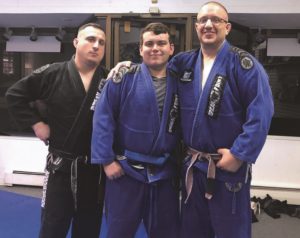ORLEANS — Medieval Japanese warriors, known as Samurai, were renowned for their legendary swordsmanship. They also were trained to survive without their weapons by employing the traditional martial art of jujitsu.
Considered the mother art for martial arts that followed, jujitsu’s oldest known styles date to the 12th century, according to Remiguisz Borda and Marian Winiecki, who wrote The Illlustrated Ninja Handbook. The practice emphasizes joint locks and redirection of the opponent’s energy as in aikido, punching and kicking as in karate, and throwing and grappling as in judo. The practice also includes kendo, akin to fencing, and tameshigiri, which evolved from being a way to test sword quality into a way of testing sword skills.
Japanese jujitsu can lay claim to being the first truly mixed martial art.
When the word jujitsu is used in the context of mixed martial arts today, it usually refers to a method of ground fighting created in the 1920s by the Gracie brothers of Brazil. After learning judo from a Japanese master, they adapted the art form (and the spelling) into a system of takedowns, grappling moves, and submission techniques known today as Brazilian jiu-jitsu.
After Japan’s post-World War II transformation, when the country’s martial arts shifted from true combat training to practices centered on the development of character and spirit for people of all ages and genders, martial arts schools sprang up like mushrooms across the U.S.
John Herring, a brown-belt Brazilian jiu-jitsu competitor and teacher under trainer Michael Deluca, has been teaching the martial art at Nauset Fit Co. in Orleans for just under a year.
Herring began practicing jiu-jitsu in 2006. “I was unhappy and overweight,” he said on Saturday before teaching two classes at the gym alongside fellow trainers Ben Wollman and Jazmyn Jones. “Then, I found myself in the Dungeon,” he said, referring to the mixed martial arts academy in Dennisport.

Herring, a career special educator, trained at the academy for four years. He later started an afterschool jiu-jitsu program at Monomoy Regional High School.
“It started with four students, and has ballooned since then,” Herring said. He extended the martial arts training, adding a Friday night class for students and adults at the Chatham Community Center in 2017.
The pandemic shut the program down, but Herring has started up again in Orleans, where he teaches a Friday night class and two Saturday classes for kids and adults.
On Saturday, the first group of students were ages three to six.
Mostly, the kids focus on basic maneuvers and proper falling technique. For students this young, those moves are done with a few giggles.
Herring tolerates bathroom breaks, runs to hug mom, and occasional crying from a baby sibling, aiming to keep the class light and fun so the kids can enjoy a new activity and burn some energy.
“The best part about teaching the little kids is the conversation,” Herring said.
Being a special educator, Herring has encouraged students with ADHD or those on the autism spectrum to try jiu-jitsu.
“I had a really good group of goofy people, in a good way, in Chatham,” he said. “I want the quietest, quirkiest bunch of kids.”
In his new class, he said, “I’ve even had kids and adults who are transitioning. We welcome all walks of life.”

Students ages seven and up entered Herring’s dojo after the younger group finished on Saturday. The second class was more sophisticated, with students practicing specific techniques and grappling on the ground in pairs.
In a real competition, two fighters grapple on the ground, each attempting to pin the other to the point of no escape.
Part of the training includes learning how to fight safely and know when to deploy a tap. When a competitor taps the floor or an opponent it’s a sign the fight needs to stop.
The class is meant for both fun and serious practice. It’s a mix of adults looking for another form of physical exercise, kids looking to get some energy out and learn discipline, and some who take the sport seriously and want to compete.
Brewster resident Caroline Metz moved to the Cape with her son Matthew, who is going into second grade at Stony Brook Elementary School, about a year and a half ago. She’s been bringing Matthew to Herring’s jiu-jitsu class for the last three months.
“There are few physical activities he enjoys this much,” she said. She appreciates the fact that John understands children’s learning differences as well.
Ted Swidzinski is originally from Orleans but recently moved to Mashpee with his son Ethan. Ted and Ethan make the drive to attend Herring’s class weekly.
Ethan is drawn to the class because “it’s really cool to learn new things,” he said. He’s intrigued by the range of techniques involved.
His father spent most of the class grappling with another student, Manuel Andino. Andino, from Brewster, said he feels a lot more confident in his physical abilities after about eight months of training in jiu-jitsu. “This has been a game changer for my overall fitness development,” he said. “It’s something you can take with you around the world.”
He said he also enjoys the good feeling Herring cultivates among teachers and teammates in the class. A traditional dojo is a place for immersive learning, but this one’s also a place for feeling like family.
Tom Recchio, a writer for the Independent and a fifth-degree black belt in jujitsu, contributed background on the traditional practice for this story.
